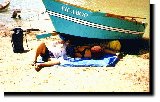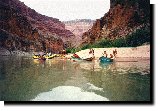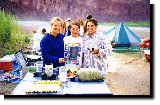|
Friday, August 8, 1997
The Saga of the Ring
Somewhere around 3:00 a.m. while I was lying awake in my tent looking up through the doorway, and watching the stars overhead I decided to climb out to stretch my legs. It was a beautiful, clear night with stars amazingly sharp and bright. The steady sound of the river running down and over the rocks of House Rock Rapids a little down stream from our camp was soothing to me, as I reclined in the sand with my back resting against a leaning boulder. A half hour later the cool early morning breeze, the rushing water and the brilliant stars had made me sleepy again, and I prepared to reenter my tent. Standing up from my comfortable seat I brushed the sand off of my rump. My wedding ring slipped off!
Uh - oh.
You have got to know the story of the ring to really appreciate my alarm.
Many years ago, while using a mattock to clear scrub oak and pecan trees from our front pasture I lost this ring. Working all day in the field, slipping my heavy work gloves on and off many times, somehow - somewhere the ring had slipped off. I had no idea in what part of the pasture it had fallen. It was gone, and I felt terrible about it.
Over the next several years we had the field disced up, planted in Bermuda grass, disced again and planted in alfalfa, then in Lespedeza, and finally disced again and replanted in Bermuda.
Ten years later when our son, Robert, was in his early teens he was on our tractor mowing the field. He noticed something gleaming in the sunlight. Not wanting the mower blades to hit it and run the risk of having the object slung at him, he stopped the tractor and picked the object up. It was a wedding ring. In the kitchen Peggy took a close look at it. Imagine her shock when on the inside of the ring she read the inscription,
"TO BOB FROM PEGGY WITH LOVE. 8/9/53"
My wedding ring!
That thing had been plowed under and up again three or four times over ten years. And there it was. On the kitchen table.
That was a very special ring.
That's not the end of the story.
I lost it again on the "Horsey Hundred" century ride in 1995. My brother had invited me to come to Lexington to join him on the ride put on by The Blue Grass Cycling Club of Lexington every Memorial Day. We had finished our breakfast at Georgetown College, and we were about 15 to 20 miles into the ride, well on up toward Paris, KY when I missed the ring. Remembering that I had removed my gloves to use the rest room, I wondered if the ring might have slipped off at that time. But my gloves had been off and on several times before then and since then. I really had no good idea as to where it might have been lost. Once again I felt awful. I couldn't believe that I had been so stupid.
Well, there was nothing left to do but to continue on, and worry like crazy about what I would tell Peggy about it that evening.
We had a nice picnic lunch in Versailles, traveled past many of the horse farms around Lexington, coasted down country lanes along deep creek valleys so lovely and shady in the late Kentucky spring, and took many pictures as we rode over the rolling blue grass farm land with its incredibly rich loam. It would have been a lot more fun if I hadn't lost the ring.
Slowly riding up the looping drive to the Community Center of Georgetown College at the end of the hundred mile ride we saw a young lady approaching us waving something over her head.
"Is your wife's name Peggy?" she asked me when I got within hearing range. (That's pretty close when you've got hearing like mine.)
"Yes." I replied.
"Is your anniversary August 9th?"
"Sure it is." I smiled. I could see that she was waving the ring.
The ring had been found in the men's room, and the guy who found it had turned it in to the people at the desk. This young lady had found the inscription, then scanned the list of riders to find all of the guys named Bob, and she was checking each one of them to find the one married to Peggy on 8/9/53. Pretty smart. Also pretty thoughtful.
Whew!
Once again I had my ring back.
Now you may have some idea of how crushed I was when in the light of my flashlight I couldn't see where my ring had fallen that night at Hot Na Na Wash.
Shining my flashlight in ever widening circles around me, not moving my feet, I carefully searched the area around me. I kept my feet motionless for fear of burying the ring in the loose sand. After about 15 minutes of this I very carefully took a long step backward, and searched the area again from different angles - always careful to skirt the area widely so as not to disturb the sand where it might have fallen.
Finally, reluctantly - very reluctantly - I gave up. There was one last chance. Maybe with his better eyes Bill would be able to see the ring in the dark. I woke him up, not an easy thing to do with that zombie, but after considerable effort He roused, cleared his mind and understood the emergency.
That guy strolled down to the scene of the tragedy, had me point out to him exactly where I had been standing when the ring fell off, ( easy for me to do since my undisturbed footprints were plainly visible) bent down to search the area by sifting the sand through his fingers. He began to gently finger the sand next to the rock where I had been sitting. Immediately he stood up holding the ring in the light of the flashlight.
"That it?" he asked.
That old, trite phrase, "I couldn't believe my eyes!" really applied to my feeling that night. What a relief! What gratitude.
Bill assured me that it was going to cost me. He still doesn't know what. He's thinking about it. But whatever the cost, if I'm able, I'll gladly pay it. - - - At least I think I'll gladly pay it. Bill comes up with some pretty wild ideas.
All of this excitement had me wide awake by 5:00 a.m.. Strolling down to the beach I found our trip leader, Factor Grua, already up and about preparing camp for breakfast. In the next few days I learned that Factor was up, and briskly working by 5:00 o'clock every morning. Very soon after Factor's stirring around all of the guides were up and working on breakfast preparations, sorting things out to break camp and performing the hundreds of little tasks required to get us on our way early in the day.
Having been well fortified with one of Dennise Gackstetter's hearty breakfasts we were aboard our dories cruising down the river by 8:00 o'clock. Pretty amazing. Bill, Matthew and I had boarded Roger Dale's "Roaring Springs."
Roger, who hales from Tucson, AZ, is the brother-in-law of Ote (Coyote) Dale, also one of our guides. Ote is captain of "Vale of Rhondda". (Not a typo. Rhondda is spelled with two ds.) He is not only a very strong and skilled river captain, but also a very fine artist who owns and operates Dale Studios, (blown and cast glass.) He can be reached at:
Dalestudio@aol.com .
A few hundred yards below our camp site we were drenched by House Rock Rapids, named for the House Rock Valley high above us to the West. The rains that fall on House Rock Valley drain into House Rock Canyon which drains into Rider Canyon, whose floods spill into the Colorado bringing with them the debris that causes the turbulence that is House Rock Rapids. The river drops just 10 feet here, but the difficulty is rated 7 to 9 depending on the river flow. I think it was at least an 8 when we went through.
There's an interesting story about how House Rock became a name out in the Canyon country. Frederick Dellenbaugh, who was a nineteen year old kid when he helped Major Powell on Powell's second canyon exploration in 1871, wrote in 1904,
"A number of us were left for a while in camp in a valley lying between the Kaibab Plateau, then called Buckskin Mountain, and what is now called Paria Plateau, at a spring in a gulch of the Vermilion Cliffs. Two large rocks at this place had fallen together in such a way that one could crawl under for shelter. This was on the old trail leading from the Mormon settlements to the Moki country, traveled about once a year by Jacob Hamblin and a Party on a trading expedition to the other side of the river. Somebody on one of these trips had taken refuge beneath this rock, and on departing had written, in a facetious mood, along the top with a piece of charcoal, Rock House Hotel . . . From this came House Rock Valley, and the name was soon a fixture, and went on our maps. And thus easily are names established in a new country."
Jacob Hamblin, by the way, is one of my heroes. This gentleman was a very tough, very honorable and respected early Mormon explorer, rancher and missionary. He was held in such esteem by the Indians, the Gentiles and the Mormons alike that he was often called upon by Brigham Young to mediate particularly difficult disputes that so often plagued the area. He was know as the Buckskin Prophet. Major Powell frequently wrote of him, and spoke highly of him. Powell says of Hamblin that he spoke seldom, spoke slowly and in a low voice, but such was his power that conversations ceased as all listened intently to what he had to say.
The feature article in the September, 1997 issue of Natural History is, "Fire and Water, The Making of the Grand Canyon," and it is written by W. K. Hamblin and his daughter, Laura Hamblin. W. K. Hamblin is professor emeritus of geology at Brigham Young, and Laura Hamblin is assistant professor of English at Utah Valley State. I bet that they are related to Jacob Hamblin.
Three miles down from House Rock Rapids we pulled into the beach at North Canyon for a pleasant half mile hike up to the polished rock pool. Bill and I had been here twice previously, once with Canyoneers in 1989 and once with OARS in 1993, and it is still as captivating as ever.
It is an easy hike if you wear shoes that have a pretty good grip in the soles. This year I made the mistake of wearing my US Divers SCUBA diving booties. Those slick soles turned a pleasant hike into a real chore, almost frightening in some places. Don't do it that way. Sandals, walkers, hikers or anything that will grip the sloping rocks will be OK, but don't wear slick soled shoes up North Canyon.
It was good to get warmed up a little before plunging into the "Roaring Twenties." North Canyon Rapid was an easy 5 with a 12 foot drop at the start of our afternoon cruise, and Twenty One Mile Rapid a third of a mile downstream was only a slightly choppy 5 foot drop rated a 5. Then I got a little wet because I was looking at the tall column of Supai rock on top of the west cliff, a phallic symbol known as "Long Indian Dick," and Indian Dick Rapid caught me by surprise.
We slopped through 23 and 1/2 Mile Rapid just downstream from Indian Dick, and then pulled over to the small beach on the left bank for our mid-day break. The sun on my back felt good as I relaxed with my lunch. Kathy MacDonald had a feeling that she may have scraped the bottom of her boat, "Ticaboo" so she had several of us haul it out on a big, inflatable roller that Roger produced from somewhere. By tipping the hull see-saw fashion over the roller she was able to inspect the hull bottom, find the damaged area, and with Roger's help re-seal it, sort of like an elaborate repair of an inner tube.
 - KATHY & ROGER REPAIRING THE TICABOO - KATHY & ROGER REPAIRING THE TICABOO
A little later, Factor led us on a brief hike up to a juniper that had graphiti carved on it by a guy named Harry McDonald when he was with the Stanton expedition back in 1890. The way I understand it if you carve your name on a tree today you are defacing it. If you had done it in 1890 you would have created a thing of historical interest that would later become a national landmark. Anyhow, this guy, Harry McDonald, left Stanton's group down at a creek on the north side of the canyon that was then known as West Fork Stanton renamed it McDonald Creek on the spot. This drainage is now called Crystal Creek, because of its crystal clear waters.
The famous, catastrophic flood of December, 1966 washed boulders up to 5 feet in diameter down Crystal Creek, and out into its delta in the Colorado, changing what had been a benign thing, not much more that a riffle, into on of the most dangerous rapids in the entire canyon.
At the completion of our history lesson at Mcdonald's tree we plowed down through 24, 24 1/2 and 25 Mile Rapids, whoosh - whoosh - whoosh, one right after another. Twenty Four is easily an 8, while the others are around 6. Still, by the time you get down through Cave Springs, Tiger Wash and MNA, rated 6, 5 and 4 at mile 27 you are pretty well soaked, and on a cloudy day you are pretty well chilled. Luckily we had enough sunshine breaking through now and then that none of us really got cold.
We cruised leisurely on down through 29 Mile Rapids, and a mile farther on came to a nice camp site at the Fence Fault where a fresh water spring percolates through the tamarisks on the west bank. The water in this spring is a pretty cold 60 degrees, but that's a lot warmer than the 51 degrees of the river, and that makes it a pretty good place to bathe, - not that any of us needed a bath at this point.
 - FENCE FAULT CAMPSITE - FENCE FAULT CAMPSITE
Along the way this day Roger had pointed out the appearance of the Redwall Limestone as it seemed to slope up out of the river around mile 23 or so, right about where you also see Long Indian Dick. The Redwall is a compact layer of limestone and dolomite, which is compressed limestone, and it looks red because it has been stained by the iron oxide that has washed down over it from the Hermit Shale and Supai layers above. Major Powell called it marble. Since marble is highly compressed limestone and/or dolomite Powell was not too far off. Identifying it as marble or a marble-like material gave this part of the canyon its name, Marble Canyon.
One of the most shocking things of this entire eventful day was the fact that Matthew volunteered to help wash the dishes after dinner. Bill thinks that may be a first. We were careful not to call attention to this laudable activity lest the spell be broken. In front of the other campers and guides we preferred to act as though this was a perfectly normal thing in Matthew's life. As a matter of fact it proved to be a normal thing in Matthew's canyon life. He helped with just about every meal after that.
 - KATHY, MATTHEW AND NICHOLE DOING DISHES - KATHY, MATTHEW AND NICHOLE DOING DISHES
Bill was so proud that I could hardly stand him. He's that way about his grandchildren.
|